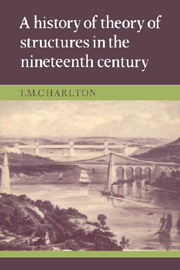Book contents
- Frontmatter
- Contents
- Preface
- 1 Introduction
- 2 Beam systems
- 3 Theory of the arch and suspension bridge
- 4 Elementary theory of frameworks: graphical statics
- 5 Theory of statically-indeterminate frameworks: the reciprocal theorem
- 6 Levy's theory of frameworks and bridge girders
- 7 Early developments of energy principles relating to theory of structures
- 8 The later development and use of energy principles
- 9 Applications of the least work principle: elastic theory of suspension bridges
- 10 Aspects of the further development of theory of structures
- 11 Secondary effects in structures
- Appendices
- I A note on C.L.M.H. Navier, based on an obituary notice by Baron de Prony
- II A note on Carl Culmann
- III A note on John Robison
- Bibliography
- Name index
- Subject index
II - A note on Carl Culmann
Published online by Cambridge University Press: 18 September 2009
- Frontmatter
- Contents
- Preface
- 1 Introduction
- 2 Beam systems
- 3 Theory of the arch and suspension bridge
- 4 Elementary theory of frameworks: graphical statics
- 5 Theory of statically-indeterminate frameworks: the reciprocal theorem
- 6 Levy's theory of frameworks and bridge girders
- 7 Early developments of energy principles relating to theory of structures
- 8 The later development and use of energy principles
- 9 Applications of the least work principle: elastic theory of suspension bridges
- 10 Aspects of the further development of theory of structures
- 11 Secondary effects in structures
- Appendices
- I A note on C.L.M.H. Navier, based on an obituary notice by Baron de Prony
- II A note on Carl Culmann
- III A note on John Robison
- Bibliography
- Name index
- Subject index
Summary
Carl Culmann was born 10 July 1821 in Bergzabern, Rheinpfalz, and died in Zurich, 9 December 1881.
After completing his studies in Karlsruhe he ‘worked on railway construction in mountainous country and later (1848) was transferred to the office of the Royal Railways Commission in Munich.
In the summer of 1849 the Railways Commission sent him on a two-year study tour of the British Isles and the U.S.A. The period of this tour coincided with the completion of the wrought iron Britannia (tubular) Bridge by Robert Stephenson and with the end of a phase of intensive development of wooden bridge construction in the U.S.A. The substance of Culmann's report of the tour was published in Allgemeine Bauzeitung in 1851 under the title ‘A description of the latest advances in bridge, railway and river-boat construction in England and the United States of North America’. It aroused great interest and established Culmann's reputation as a young engineer with outstanding qualities of perception. Indeed, it seems to have been a material factor in his leaving the railway industry in 1855 to teach at the newly established Federal Polytechnic Institute at Zurich, where he believed he would have greater opportunities for combining theory and practice of engineering.
Culmann clearly recognised the urgent need to develop Navier's methods for application to the design of railway bridges and his report emphasised methods of calculating the forces in the new bridge forms to enable them to be exploited with confidence in their safety.
Information
- Type
- Chapter
- Information
- A History of the Theory of Structures in the Nineteenth Century , pp. 169 - 171Publisher: Cambridge University PressPrint publication year: 1982
